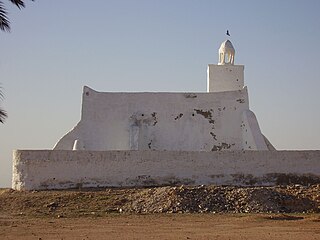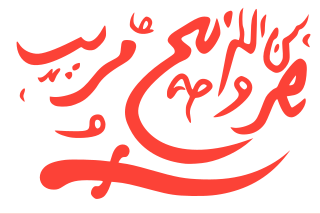Related Research Articles

Oman is a site of pre-historic human habitation,stretching back over 100,000 years. The region was impacted by powerful invaders,including other Arab tribes,Portugal and Britain. Oman,at its height,held holdings that ranged from the Persian Gulf all the way south to the island of Madagascar,some notable holdings include;the island of Zanzibar,the city of Mogadishu and the city of Gwadar.

The Ibadi movement or Ibadism is a branch inside Islam,which many believe is descended from the Kharijites. The followers of Ibadism are known as the Ibadis or,as they call themselves,The People of Truth and Integrity.

Islam is the state religion in Oman,introduced during the Prophet Muhammad's lifetime in the early 7th century. Muhammad appointed Amr ibn al-As as governor,who remained until Muhammad's death in 632 CE. Amr and Sa'id ibn Aws al-Ansari delivered Muhammad's letter to the Al-Julanda brothers;the rulers of Oman,inviting them to embrace Islam. This peaceful mission marked the beginning of Islam in Oman. Today,85.9% of Oman's population is Muslim,with slightly over 45% following Sunni Islam,and around 45% Ibadi Islam,with the other 5% identifying as Shia Muslims.

The Sultanate of Muscat and Oman,also known briefly as the State of Muscat and Oman during the rule of Taimur bin Feisal,was a sovereign state that encompassed the present-day Sultanate of Oman and parts of present-day United Arab Emirates and Pakistan,in the second half of the 19th century and 20th century. Ruled by the Busaid dynasty,it was established as a result of the partition of the Omani Empire upon the death of its last ruler Said bin Sultan. The Sultanate transitioned into a new form of government after the palace coup of 23 July 1970 in which the sultan Said bin Taimur was immediately deposed in favor of his son Qaboos bin Said.

Michael Allan Cook FBA is a British historian and scholar of Islamic history. Cook is the general editor of The New Cambridge History of Islam.

The Imamate of Oman was a historical state within the Oman proper in the Hajar Mountains,part of the present-day Sultanate of Oman. The capital of the Imamate alternated historically between Rustaq and Nizwa. The Imamate's territory extended north to Ibri and south to the Alsharqiyah region and the Sharqiya Sands. The Imamate was bounded in the east by the Hajar Mountains and in the west by the Rub' al Khali desert. The Al Hajar Mountains separated the Imamate of Oman from Muscat and Oman. The elected Imam (ruler) resided in the capital,and Walis (governors) represented the Imamate in its different regions.

The Treaty of Seeb was an agreement reached between the sultan of Muscat,Taimur bin Feisal,and the Imamate of Oman on 25 September 1920. The treaty granted autonomy to the imamate in the interior of Oman but recognized the sovereignty of the Sultanate of Muscat. The treaty was named after Seeb (as-Sib),a coastal town in present-day Oman.

Laura Veccia Vaglieri (1893–1989) was an Italian orientalist who made significant contributions to Arabic and Islamic studies in Italy. She was a scholar and served as a professor at the University of Naples "L'Orientale". Her research focused on the historical and institutional analysis of the Arab and Muslim world,and she authored several books on these topics. Additionally,Veccia Vaglieri wrote numerous articles on early Islam and on Ibadism. Her work also included contributions to the Encyclopaedia of Islam and the history of research on Ibāḍīstudies.

The Wajihids were an Arab dynasty that ruled in coastal Oman in the early and mid-10th century AD. Their capital was the town of Suhar,after moving there from Al-Buraimi Oasis or Tawam,where they had been in the 9th century.
The Hināwī are one of two major tribal groupings of Oman and the Trucial Coast,the other being the Ghāfirī. Characterized as two significant factions having distinct interests and organizations,their rivalry began approximately 2000 years ago;almost during the time Ghafiris arrived to Oman. The Hinawis,for the most part,resided in southeast Oman,while the Ghafiris predominated in the northwestern part of Oman. Several tribal groups make up the Hinawi alliance,such as,the Dhowahir,Beni Yas,and the Awamir,Beni Hina and the Harasis. During the 18th century,serious conflicts occurred between the two factions. These conflicts only ended after many sub-tribes were united under one leader that belonged to one of the two factions. The Hinawis gathered under Khalaf bin Mubarak Alhinai from the Bani Hina tribe,while the Ghafiris gathered under Mohammed bin Nasir Alghafiri of the Beni Ghafir tribe. The almost equal strength of the two alliances led to the end of the feud. The rivalry played a decisive role in shaping the political history of Oman,with Omani tribes affiliating themselves historically with either the Ghafiri or Hinawi alliances.

The Nabhani dynasty,members of the Bani Nabhan family,also referred to as the Sultans of Sohar,were rulers of Oman from 1154 until 1624,when the Yaruba dynasty took power. One of their most visible legacies is the Bahla Fort,a large complex of mud brick buildings on stone foundations built from the 12th to the 15th century. It was registered in 1987 as a UNESCO World Heritage Site.
Muḥakkima and al-Haruriyya refer to the Muslims who rejected arbitration between Ali and Mu'awiya I at the Battle of Siffin in 657 CE. The name Muḥakkima derives from their slogan lāḥukma illāli-llāh,meaning "no judgment (hukm) except God's". The name al-Haruriyya refers to their withdrawal from Ali's army to the village of Harura' near Kufa. This episode marked the start of the Kharijite movement,and the term muḥakkima is often also applied by extension to later Kharijites.
Ibadism,or the Ibadi school of Islam,which has followers in Oman and elsewhere,has been the subject of much academic study. Much of the earlier writings from within the Islamic world presented Ibadism as a heresy. Western academic interest in Ibadism began in the mid-19th century,when translations of Ibadi texts and other literature began to become available. French and Italian scholars focussed mainly on Ibadism in North Africa,while John C. Wilkinson and other British scholars have studied it in Oman,where few texts were accessible until the 1970s.
Ibāḍītheology refers to the study of God within the Ibāḍībranch of Islam,and shares a path with Islamic theology. Although the school was founded in Basra,modern-day Iraq,its followers subsequently sought refuge in Oman,Yemen,Hadramawt in the southeast peninsula of Arabia,and North Africa. Though largely ignored by the mainstream of Arab and Muslim scholarship,and scarcely tapped by Orientalist research,there does exist a continuous tradition of Ibāḍīscholarship throughout the centuries to this day.
Several Omani/Ibadi manuscripts discovered over the past four decades,particularly in the Sultanate of Oman and North Africa,contain the texts of what is commonly termed “sirah”(“history”) or “jam’al siyar”. They belong to a familiar type of literature,a genre used when addressing the general public in mosques in the early Islamic era centuries.
Valerie Hoffman is an academic scholar on Islamic studies expertise on religion,anthropology of Islam and Ibadi studies.
Ziaka Angeliki is an academic scholar on Islamic studies expertise on Byzantine studies,Ibadi Studies and Shia Studies.
Adam Russell Gaiser is a scholar of Islamic studies specialising on the development of early Kharijites and Ibadiyya.
Dale F. Eickelman is an American anthropologist with an expertise on the Middle East. He is the Ralph and Richard Lazarus Professor of Anthropology and Human Relations at Dartmouth College.
Nur al-Dīn al-Sālimī was an Omani historian and scholar noted for his expertise in IbāḍīIslam. Al-Sālimīis a very important figure in Oman with reference to his publications. Among his publications are Tuḥfat al-Aʿyān bi-sīrat ahl ʿUmān and Talqīn al-ṣibyān. Both references are taught in public schools.
References
- 1 2 3 "Experts on Ibadhiyah". www.islam-in-oman.com. Retrieved 11 April 2019.
- ↑ Custers, Martin H. (2016). Al-Ibāḍiyya: A Bibliography. 3 (Second revised and enlarged ed.). Hildesheim-London-N.Y.: Olms Publishing. p.706.
- ↑ Gaiser, Adam. “Ibadism: Origins and Early Development in Oman. By John Wilkinson.” Jerusalem Studies in Arabic and Islam 39, 2012, p. 468.
- ↑ Valerie Hoffman, Book Review: John C. Wilkinson, Ibâḍism: Origins and Early Development in Oman (Oxford Oriental Monographs, Oxford University Press, 2010) in Der Islam 91, 2, 2014, p. 447.
- ↑ Custers, Martin H. (2016). Al-Ibāḍiyya: A Bibliography. 3 (Second revised and enlarged ed.). Hildesheim-London-N.Y.: Olms Publishing. pp. 706-712.